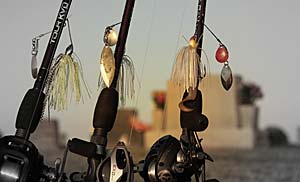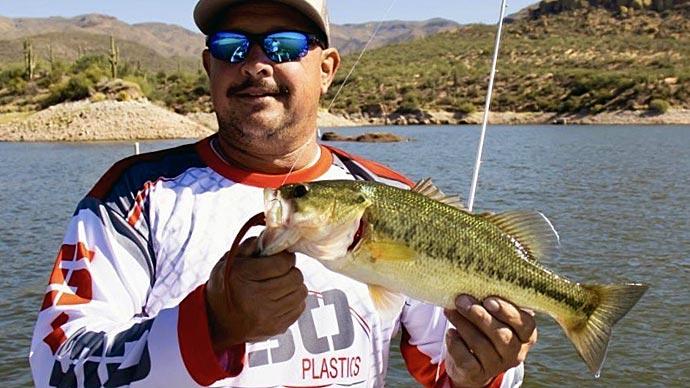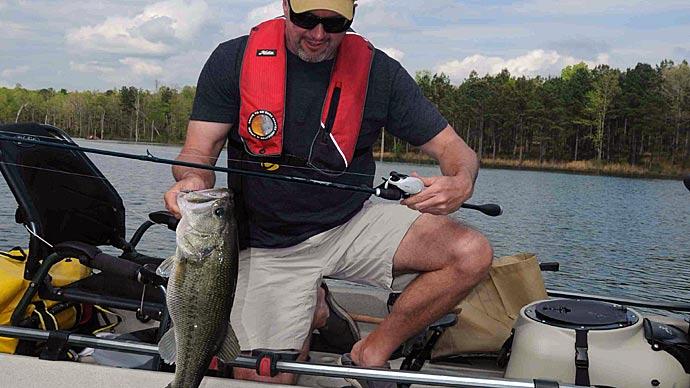
Today's angler is blessed when it comes to lure selections. Tackle store shelves are packed with just about everything you could want to fool ol' bucket mouth with. Each passing year offers new designs and innovations to lures that almost carry written guarantees to catch more and bigger fish. Many new lures and lure products aren't even available at your local tackle shop. Instead, they're presented through the all-powerful media of video. You've seen them, I'm sure. Hosted by fishing show personalities, fishing on well-stocked, private impoundments that we poor mortals can only dream about. Nearly every cast produces a potbellied lunker.
Dream on, friends. You'd be amazed if you knew how many hours and days it takes to put seven to eight big fish on film, even on stocked ponds.
Throughout the video, the host will show you the product in close-up detail. He'll tell you it's the greatest thing since Tootie Fruity ice cream. Most of these presentations are packaged items that can only be purchased by order. They have some merit, but there's also a lot of frills and hype meant to catch you, not the fish. Buyer beware.
I want to tell you about a process that I've been doing for many years, to new and old lures. I like to call it lure modification. It's fun and less expensive than buying every new lure you see in the shop or on television.
I am a confirmed, dyed-in-the-wool, shallow-water bass chaser. But I will still cruise some of the 10- to 12-foot depths if fish are there and hungry. It could be I'm a little foolish, but stupid, I'm not. However, the following sketches and explanations are some of my preferred shallow-water lures. These consist of spinnerbaits, buzzbaits, Pop Rs, and Prop Darters.
The spinnerbait has been my "rock" since 1960 and will continue to be as long as I can cast. So what I'm about to tell you about spinnerbaits, you can take as gospel.
My preferences in blades are Colorado, Indiana, and willow leaf. Nickel, gold, and copper are the finishes I've found to be the best. All my blades must be hammered because they produce more vibration and feel better than those with painted or smooth surfaces.
Be particular about spinnerbait skirts also. My choice is metal-flake, round-strand silicon. I find them tougher than the flat strands, and they offer better action.
One of the most vital aspects of a spinnerbait is the terminal point. I encourage you to purchase the twist-loop tie if you can find them. Most spinnerbait manufacturers are making the open-loop or R-bend tie point. It does have a couple of good points, though. The R-bend eliminates line getting wedged in the twist and shortens building labor time.
My reason for pushing the twist-loop is simple. It's twice as strong as the R-bend. I often purchase spinnerbaits with R-bends, and the following is one of my "must-do" modifications.
Purchase hollow metal tubing with an inside diameter large enough to slip over the R-bend. I like mine, about 1/8-inch long. Using pliers, compress the tube until it's slightly oval. Now, slip it over the bend and crimp it to close and secure the gap. That's it. File off the rough edges and forget worrying about breaking the spinnerbait.
I've always tried to match my spinnerbait hardware to the type of structure I'm fishing. For instance, the Colorado blade is the best in hard timber and rocks. However, the willow leaf blade will be the best to use if you're working a combination of stiff brush and weeds.
Above all, insist on Sampo ball-bearing swivels. They're the best.
You can pick out your favorite spinnerbait and trim the skirt to within 1/4-inch of the hook's bend. This will accomplish two things. First, it shortens the strike zone and will eliminate any interference of the following attachment.
Next, attach a #3 Colorado blade on a Sampo swivel over the hook's point as a keeper for the tail teaser. You won't believe the improved feel and balance that this simple attachment provides.
Next to spinnerbaits, I thoroughly enjoy fishing a buzzbait. They're productive and easy to fish. Fall is a prime time to use them, but they'll also produce in summer.
I like a trailer hook on my buzzbaits. A single trailer hook will undoubtedly help you snag some short strikes, but I modified an improved trailer hook just a few years ago. I call it the "double stinger."
Use a #4 treble for the stinger. First, cut off the bottom tine that will leave the hook eye flat. Then, slip a piece of surgical tubing over the eye and impale it over the buzzbait hook. The tubing will hold the stinger in the perfect position to hang a short-striking bass.
If you don't already have a clacker on your buzzbait, bend the blade arm down until the blade barely touches the main arm. This will create a clicking sound that will call up sluggish bass on tough days.
Documented results have certainly proven that the Pop-R is a fabulous bass catcher. However, one slight modification can make it even more productive.
Just trim about 1/16-inch off the lower lip. Do it with a knife, file, etc. This reduction will cause the lure to take on the same walk-the-dog action as the famed Zara Spook. It works best of all on 10- to 12-pound test line. The addition of a small split ring will also enhance this action.
The Tiny Torpedo and Devil's Horse are good fish-catching lures. There's only one modification I make for surface-type lures. It's done by re-shaping the line-tie loop.
You can bend the loop down so that the nose of the lure will dive under the surface of the water instead of the regular forward skip on the retrieve. As a result, you'll find that the bait will stay in the strike zone longer, and its new darting action will be much better.
Always add a split ring to all surface lures to increase action. Above all, don't be afraid to alter the action or looks of your lures. An old lure can offer new catches with just a slight modification.
BassResource may receive a portion of revenues if you make a purchase using a link above.




